Research and Application of Early Identification of Geological Hazards Technology in Railway Disaster Prevention and Control: A Case Study of Southeastern Gansu, China
Abstract
:1. Introduction
2. Methodology
2.1. Data Preparation Stage
2.2. Potential Hazards Identification Stage
2.3. Regional Analysis Stage
2.4. Focused Analysis Stage
2.5. Field Verification Stage
2.6. Giving Advice Stage
3. Case Study Description and Materials
3.1. Study Area
3.2. Data
4. Results and Analysis
4.1. Potential Hazard Identification Results
4.2. Regional Analysis of Potential Risks to Network Rail
4.2.1. Potential Geohazard Development Density Map Obtained via KDA
- (1)
- Region 1 is in the northernmost part of the study area, with a core location at Lanzhou railway station. The KDA value shows moderate potential geohazard aggregation in Region 1. However, due to the importance of Lanzhou railway station as a comprehensive transport hub, it should be given priority attention.
- (2)
- Region 2 is located south of Region 1, with a significant area of high KDA values on the east side of its interior. The Lanzhou–Chongqing railway (LY Line) runs longitudinally through the eastern side of Region 2, and its length of approximately 5.2 km may pose an operational safety risk due to densely distributed potential geological hazards.
- (3)
- Region 3 is in the east-central part of the study area, and its KDA values are moderately clustered and most significant at Tianshui railway station. Tianshui railway station is a first-class station for passengers and goods in Gansu Province. It is a vital hub station for the Lanzhou–Lianyungang Railway (LH Line), Tianshui–Huating Railway (TH Line), and Xuzhou–Lanzhou Railway (XL Line). Therefore, considering the importance of Tianshui railway station in the railway network of Gansu Province, the prevention of geological disasters there is of great significance.
- (4)
- Regions 4 and 5 are located parallel to each other in the southern part of the study area, and the peak areas of KDA within them are distributed in an isolated manner. The only railway in the area is the LH Line, which crosses it in an S-shape. As such, although potential geological hazards are densely distributed within Regions 4 and 5, they merely threaten a section of the LH Line, which is approximately 124 km long.
4.2.2. Administrative Unit-Scale Disaster Density Hotspot Maps Obtained via HSA
4.3. Focused Analysis of Potential Risks to Rail Network
4.4. Field Validation of Major Potential Railway Hazard
5. Conclusions and Future Works
Author Contributions
Funding
Institutional Review Board Statement
Informed Consent Statement
Data Availability Statement
Conflicts of Interest
References
- Gansu Provincial Development and Reform Commission. “14th Five-Year Plan” and Medium and Long-term Railway Network Development Plan. 2021. Available online: https://fzgg.gansu.gov.cn/fzgg/c106108/202111/1899076.shtml (accessed on 2 October 2023).
- Jin, F.J.; Ding, J.X.; Liu, D.; Wang, C.J. Transportation development transition in China. Chin. Geogr. Sci. 2012, 22, 319–333. [Google Scholar] [CrossRef]
- Wang, W.; Cai, K.Q.; Du, W.B.; Wu, X.; Tong, L.; Zhu, X.; Cao, X.B. Analysis of the Chinese railway network as a complex network. Chaos Solitons Fractals 2020, 130, 109408. [Google Scholar] [CrossRef]
- Ministry of Transport of the People’s Republic of China. Statistical Bulletin on Transportation Sector Development, 2022. 2023. Available online: https://www.gov.cn/govweb/lianbo/bumen/202306/content_6887539.htm (accessed on 4 October 2023).
- Jiao, J.J.; Wang, J.; Jin, F.J. Impacts of high-speed rail lines on the city network in China. J. Transp. Geogr. 2017, 60, 257–266. [Google Scholar] [CrossRef]
- Wu, C.L.; Fang, D.P.; Li, N. Roles of owners’ leadership in construction safety: The case of high-speed railway construction projects in China. Int. J. Proj. Manag. 2015, 33, 1665–1679. [Google Scholar] [CrossRef]
- Yin, L.Z.; Wang, Y.F. Network characteristics and vulnerability analysis of Chinese railway network under earthquake disasters. ISPRS Int. J. Geo-Inf. 2020, 9, 697. [Google Scholar] [CrossRef]
- Cui, P.; Ge, Y.; Li, S.; Li, Z.; Xu, X.; Zhou, G.G.D.; Chen, H.; Wang, H.; Lei, Y.; Zhou, L.; et al. Scientific challenges in disaster risk reduction for the Sichuan–Tibet Railway. Eng. Geol. 2022, 309, 106837. [Google Scholar] [CrossRef]
- Liu, K.; Wang, M.; Cao, Y.; Zhu, W.; Yang, G. Susceptibility of existing and planned Chinese railway network subjected to rainfall-induced multi-hazards. Transp. Res. Part A Policy Pract. 2018, 117, 214–226. [Google Scholar] [CrossRef]
- Zhu, W.H.; Liu, K.; Wang, M.; Koks, E.E. Seismic risk assessment of the railway network of China’s mainland. Int. J. Disaster Risk Sci. 2020, 11, 452–465. [Google Scholar] [CrossRef]
- Wang, F.W.; Chen, Y.; Yan, K.M. A destructive mudstone landslide hit a high-speed railway on 15 September 2022 in Xining city, Qinghai province, China. Landslides 2023, 20, 871–874. [Google Scholar] [CrossRef]
- Chen, X.Z.; Lu, Q.C.; Peng, Z.R.; Ash, J.E. Analysis of transportation network vulnerability under flooding disasters. Transp. Res. Rec. 2015, 2532, 37–44. [Google Scholar] [CrossRef]
- Li, W.L.; Zhu, J.; Fu, L.; Zhu, Q.; Xie, Y.K.; Hu, Y. An augmented representation method of debris flow scenes to improve public perception. Int. J. Geogr. Inf. Sci. 2021, 35, 1521–1544. [Google Scholar] [CrossRef]
- Christopher, S.; Nikola, B. Passenger-centered vulnerability assessment of railway networks. Transp. Res. Part B Methodol. 2020, 136, 30–61. [Google Scholar]
- Yin, L.Z.; Zhu, J.; Li, W.S.; Wang, J.H. Vulnerability analysis of geographical railway network under geological hazard in China. ISPRS Int. J. Geo-Inf. 2022, 11, 342. [Google Scholar] [CrossRef]
- Wei, M.; Fang, S.J.; Chen, S.; Lin, R.Y.; Huang, Y.; Yang, L. Resilience Assessment of Road Networks in the Extremely Severe Disaster Areas of the Wenchuan Earthquake. Front. Earth Sci. 2022, 10, 834302. [Google Scholar] [CrossRef]
- Zheng, Q.; Shen, S.L.; Zhou, A.N.; Cai, H. Investigation of landslides that occurred in august on the Chengdu–Kunming railway, Sichuan, China. Geosciences 2019, 9, 497. [Google Scholar] [CrossRef]
- Sun, S.; Gao, G.; Li, Y.; Zhou, X.Y.; Huang, D.P.; Chen, D.L.; Li, Y.Q. A comprehensive risk assessment of Chinese high-speed railways affected by multiple meteorological hazards. Weather Clim. Extrem. 2022, 38, 100519. [Google Scholar] [CrossRef]
- Xu, Q.; Dong, X.J.; Li, W.L. Integrated space-air-ground early detection, monitoring and warning system for potential catastrophic geohazards. Geomat. Inf. Sci. Wuhan Univ. 2019, 44, 957–966. (In Chinese) [Google Scholar]
- Jiang, N.; Li, Y.; Han, Z.; Li, J.Y.; Fu, B.J.; Yang, J.M. A dataset-enhanced Linformer model for geo-hazards susceptibility assessment: A case study of the railway in Southwest China. Environ. Earth Sci. 2023, 82, 397. [Google Scholar] [CrossRef]
- Panchal, S.; Shrivastava, A.K. Landslide hazard assessment using analytic hierarchy process (AHP): A case study of National Highway 5 in India. Ain Shams Eng. J. 2022, 13, 101626. [Google Scholar] [CrossRef]
- Yoshimatsu, H.; Abe, S. A review of landslide hazards in Japan and assessment of their susceptibility using an analytical hierarchic process (AHP) method. Landslides 2006, 3, 149–158. [Google Scholar] [CrossRef]
- Bhatt, B.P.; Awasthi, K.D.; Heyojoo, B.P.; Silwal, T.; Kafle, G. Using geographic information system and analytical hierarchy process in landslide hazard zonation. Appl. Ecol. Environ. Sci. 2013, 1, 14–22. [Google Scholar]
- Aditian, A.; Kubota, T.; Shinohara, Y. Comparison of GIS-based landslide susceptibility models using frequency ratio, logistic regression, and artificial neural network in a tertiary region of Ambon, Indonesia. Geomorphology 2018, 318, 101–111. [Google Scholar] [CrossRef]
- Zhang, H.J.; Song, Y.X.; Xu, S.L.; He, Y.H.; Li, Z.W.; Yu, X.Y.; Liang, Y.; Wu, W.C.; Wang, Y. Combining a class-weighted algorithm and machine learning models in landslide susceptibility mapping: A case study of Wanzhou section of the Three Gorges Reservoir, China. Comput. Geosci. 2022, 158, 104966. [Google Scholar] [CrossRef]
- Xiong, J.N.; Sun, M.; Zhang, H.; Cheng, W.M.; Yang, Y.H.; Sun, M.Y.; Cao, Y.F.; Wang, J.Y. Application of the Levenburg–Marquardt back propagation neural network approach for landslide risk assessments. Nat. Hazards Earth Syst. Sci. 2019, 19, 629–653. [Google Scholar] [CrossRef]
- Xu, S.L.; Niu, R.Q. Displacement prediction of Baijiabao landslide based on empirical mode decomposition and long short-term memory neural network in Three Gorges area, China. Comput. Geosci. 2018, 111, 87–96. [Google Scholar] [CrossRef]
- Hong, H.Y.; Pourghasemi, H.R.; Pourtaghi, Z.S. Landslide susceptibility assessment in Lianhua County (China): A comparison between a random forest data mining technique and bivariate and multivariate statistical models. Geomorphology 2016, 259, 105–118. [Google Scholar] [CrossRef]
- Chen, Z.; Liang, S.Y.; Ke, Y.T.; Yang, Z.K.; Zhao, H.L. Landslide susceptibility assessment using different slope units based on the evidential belief function model. Geocarto Int. 2020, 35, 1641–1664. [Google Scholar] [CrossRef]
- Zhao, J.; Liu, K.; Wang, M. Exposure analysis of Chinese railways to multihazards based on datasets from 2000 to 2016. Geomat. Nat. Hazards Risk 2020, 11, 272–287. [Google Scholar] [CrossRef]
- Liu, H.; Min, O.Y.; Peeta, S.; He, X.Z.; Yan, Y.Z. Vulnerability assessment and mitigation for the Chinese railway network under floods. Reliab. Eng. Syst. Saf. 2015, 137, 58–68. [Google Scholar]
- Zhang, J.M.; Zhu, W.; Cheng, Y.Q.; Li, Z.H. Landslide Detection in the Linzhi–Ya’an Section along the Sichuan–Tibet Railway Based on InSAR and Hot Spot Analysis Methods. Remote Sens. 2021, 13, 3566. [Google Scholar] [CrossRef]
- Zhou, C.; Cao, Y.; Hu, X.; Yin, K.L.; Wang, Y.; Catani, F. Enhanced dynamic landslide hazard mapping using MT-InSAR method in the Three Gorges Reservoir Area. Landslides 2022, 19, 1585–1597. [Google Scholar] [CrossRef]
- Zhou, C.; Cao, Y.; Yin, K.L.; Wang, Y.; Shi, X.G.; Catani, F.; Ahmed, B. Landslide characterization applying sentinel-1 images and InSAR technique: The muyubao landslide in the three Gorges Reservoir Area, China. Remote Sens. 2020, 12, 3385. [Google Scholar] [CrossRef]
- Liu, S.H.; Segoni, S.; Raspini, F.; Yin, K.L.; Zhou, C.; Zhang, Y.Y.; Casagli, N. Satellite InSAR as a new tool for the verification of landslide engineering remedial works at the regional scale: A case study in the Three Gorges Reservoir Area, China. Appl. Sci. 2020, 10, 6435. [Google Scholar] [CrossRef]
- Luo, X.J.; Wang, C.C.; Long, Y.; Yi, Z.H. Analysis of the decadal kinematic characteristics of the Daguangbao landslide using multiplatform time series InSAR observations after the Wenchuan earthquake. J. Geophys. Res. Solid Earth 2020, 125, e2019JB019325. [Google Scholar] [CrossRef]
- Zheng, Z.Z.; Xie, C.H.; He, Y.; Zhu, M.C.; Huang, W.F.; Shao, T.M. Monitoring potential geological hazards with different InSAR algorithms: The case of western Sichuan. Remote Sens. 2022, 14, 2049. [Google Scholar] [CrossRef]
- Dai, K.R.; Xu, Q.; Li, Z.H.; Tomás, R.; Fan, X.M.; Dong, X.J.; Li, W.L.; Zhou, Z.W.; Gou, J.S.; Ran, P.L. Post-disaster assessment of 2017 catastrophic Xinmo landslide (China) by spaceborne SAR interferometry. Landslides 2019, 16, 1189–1199. [Google Scholar] [CrossRef]
- Dai, C.; Li, W.L.; Wang, D.; Lu, H.Y.; Xu, Q.; Jian, J. Active landslide detection based on Sentinel-1 data and InSAR technology in Zhouqu county, Gansu province, Northwest China. J. Earth Sci. 2021, 32, 1092–1103. [Google Scholar] [CrossRef]
- Meng, Q.K.; Li, W.L.; Raspini, F.; Xu, Q.; Peng, Y.; Ju, Y.Z.; Zheng, Y.Z.; Casagli, N. Time-series analysis of the evolution of large-scale loess landslides using InSAR and UAV photogrammetry techniques: A case study in Hongheyan, Gansu Province, Northwest China. Landslides 2021, 18, 251–265. [Google Scholar] [CrossRef]
- Meng, X.M.; Qi, T.J.; Zhao, Y.; Dijkstra, T.; Shi, W.; Luo, Y.F.; Wu, Y.Z.; Su, X.J.; Zhao, F.M.; Ma, J.H. Deformation of the Zhangjiazhuang high-speed railway tunnel: An analysis of causal mechanisms using geomorphological surveys and D-InSAR monitoring. J. Mt. Sci. 2021, 18, 1920–1936. [Google Scholar] [CrossRef]
- Chen, B.B.; Gong, H.L.; Chen, Y.; Lei, K.C.; Zhou, C.F.; Si, Y.; Li, X.J.; Pan, Y.; Gao, M.L. Investigating land subsidence and its causes along Beijing high-speed railway using multi-platform InSAR and a maximum entropy model. Int. J. Appl. Earth Obs. Geoinf. 2021, 96, 102284. [Google Scholar] [CrossRef]
- Meng, Z.G.; Shu, C.Z.; Wu, Q.; Yang, Y.; Fu, Z. In monitoring surface deformation of high-speed railway using time-series InSAR method in northeast China. IOP Conf. Ser. Earth Environ. Sci. 2021, 660, 012011. [Google Scholar] [CrossRef]
- Zhang, Q.Y.; Li, Y.S.; Zhang, J.F.; Luo, Y. InSAR technique applied to the monitoring of the Qinghai–Tibet Railway. Nat. Hazards Earth Syst. Sci. 2019, 19, 2229–2240. [Google Scholar] [CrossRef]
- Cai, Y.H.; Wang, R.; Yu, W.D.; Liang, D.; Liu, K.Y.; Zhang, H.; Chen, Y.F. An advanced approach to improve synchronization phase accuracy with compressive sensing for LT-1 bistatic spaceborne SAR. Remote Sens. 2022, 14, 4621. [Google Scholar] [CrossRef]
- Olen, S.; Bookhagen, B. Mapping damage-affected areas after natural hazard events using Sentinel-1 coherence time series. Remote Sens. 2018, 10, 1272. [Google Scholar] [CrossRef]
- Meena, S.R.; Nachappa, T.G. Impact of spatial resolution of digital elevation model on landslide susceptibility mapping: A Case Study in Kullu Valley, Himalayas. Geosciences 2019, 9, 360. [Google Scholar] [CrossRef]
- Batuhan, O.; Filiz, S.; Shimon, W.; Enrique, C.-C. Time series analysis of InSAR data: Methods and trends. ISPRS J. Photogramm. Remote Sens. 2016, 115, 90–102. [Google Scholar]
- Li, S.W.; Xu, W.B.; Li, Z.W. Review of the SBAS InSAR Time-series algorithms, applications, and challenges. Geod. Geodyn. 2022, 13, 114–126. [Google Scholar] [CrossRef]
- Zhang, L.L.; Dai, K.R.; Deng, J.; Ge, D.Q.; Liang, R.B.; Li, W.L.; Xu, Q. Identifying potential landslides by stacking-InSAR in southwestern China and its performance comparison with SBAS-InSAR. Remote Sens. 2021, 13, 3662. [Google Scholar] [CrossRef]
- He, Y.Y.; Lindbergh, S.; Graves, C.; Rakas, J. Airport exposure to lightning strike hazard in the Contiguous United States. Risk Anal. 2021, 41, 1323–1344. [Google Scholar] [CrossRef]
- Zhang, J.X.; Huang, W.B.; Li, T.A.; Yang, X.M.; Li, Q.; Bian, H.W. Fine meteorological risk early warning forecast of main geological disasters in Gansu Province. Arid Land Geogr. 2023, 46, 1443–1452. (In Chinese) [Google Scholar]
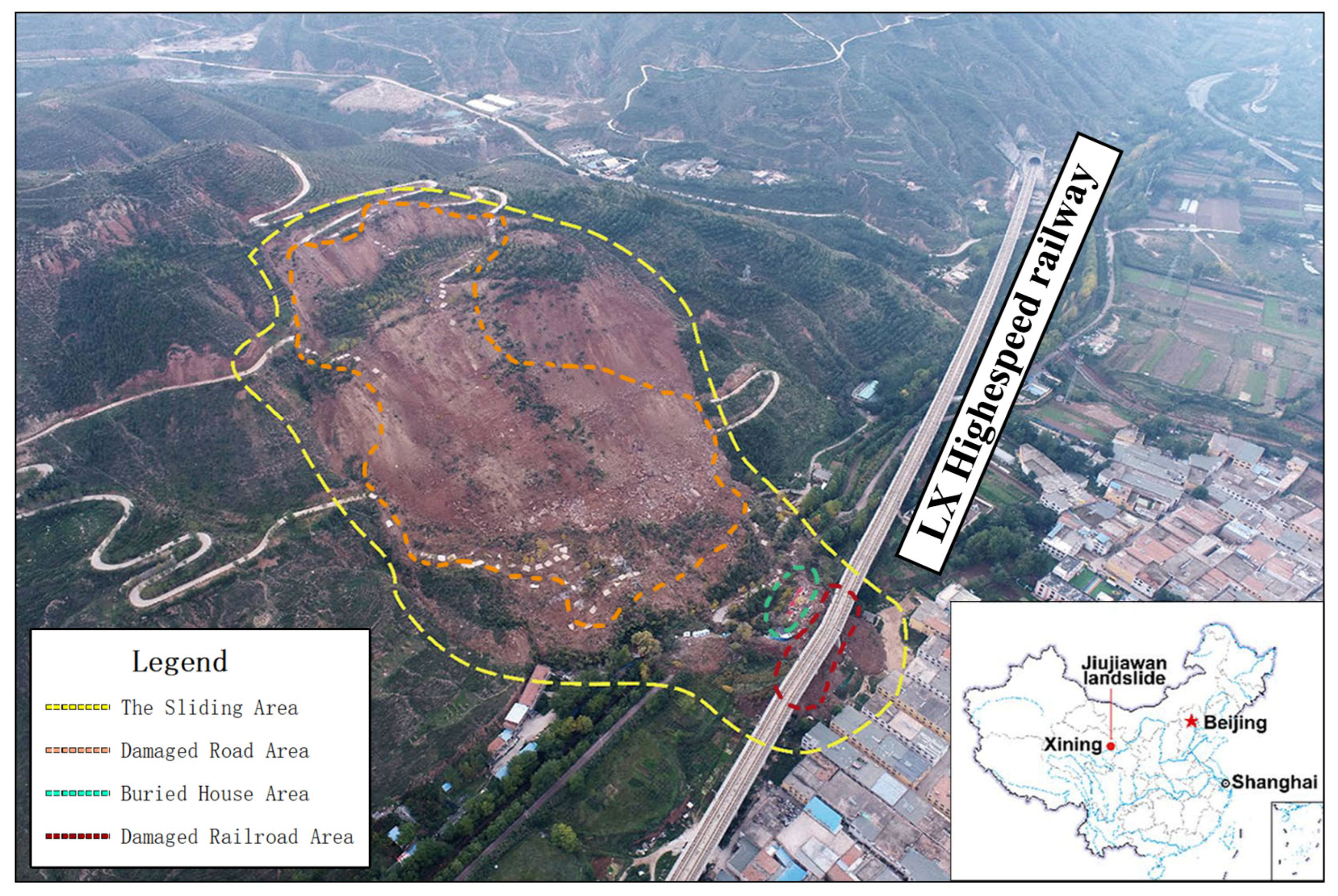
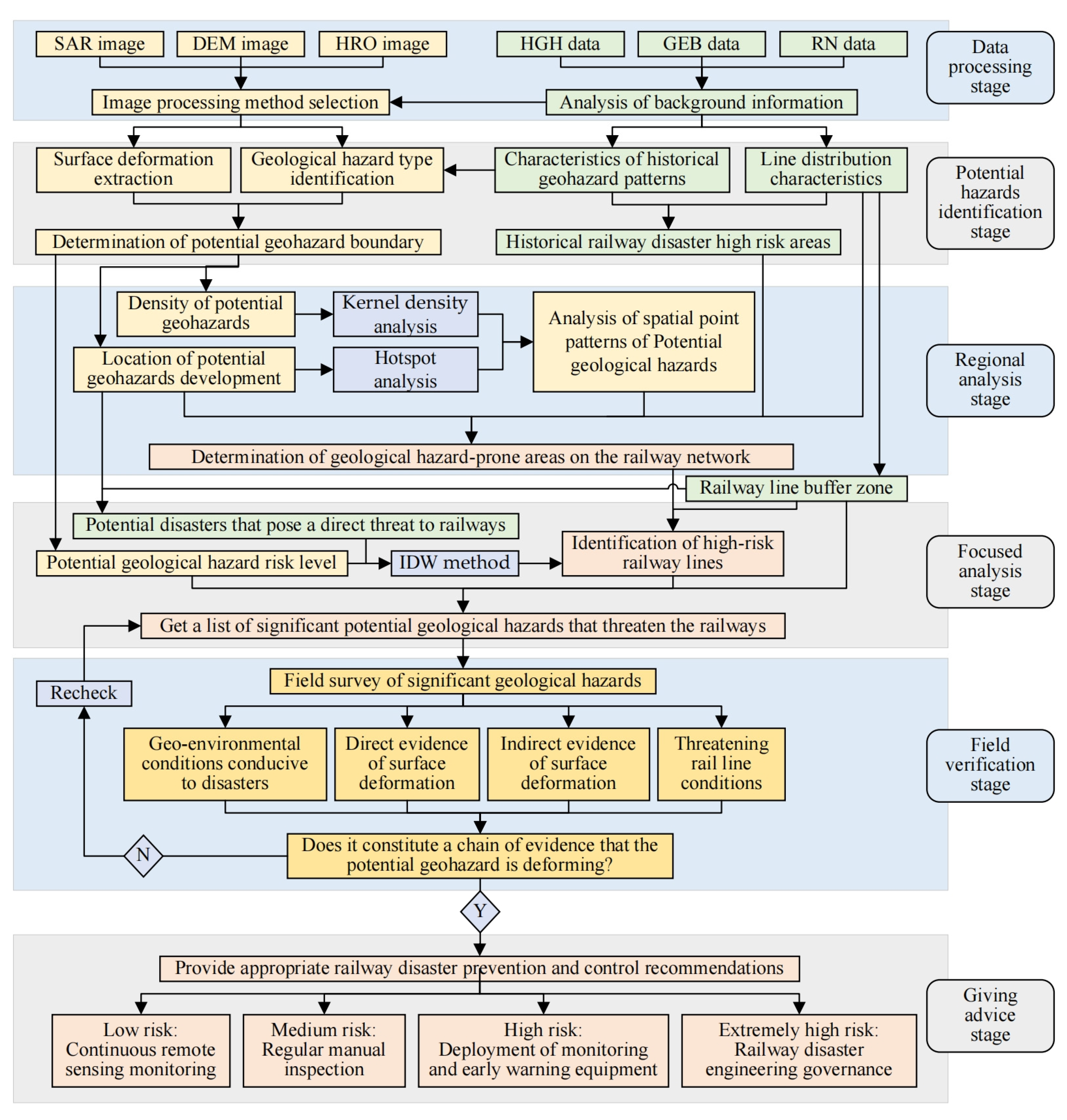
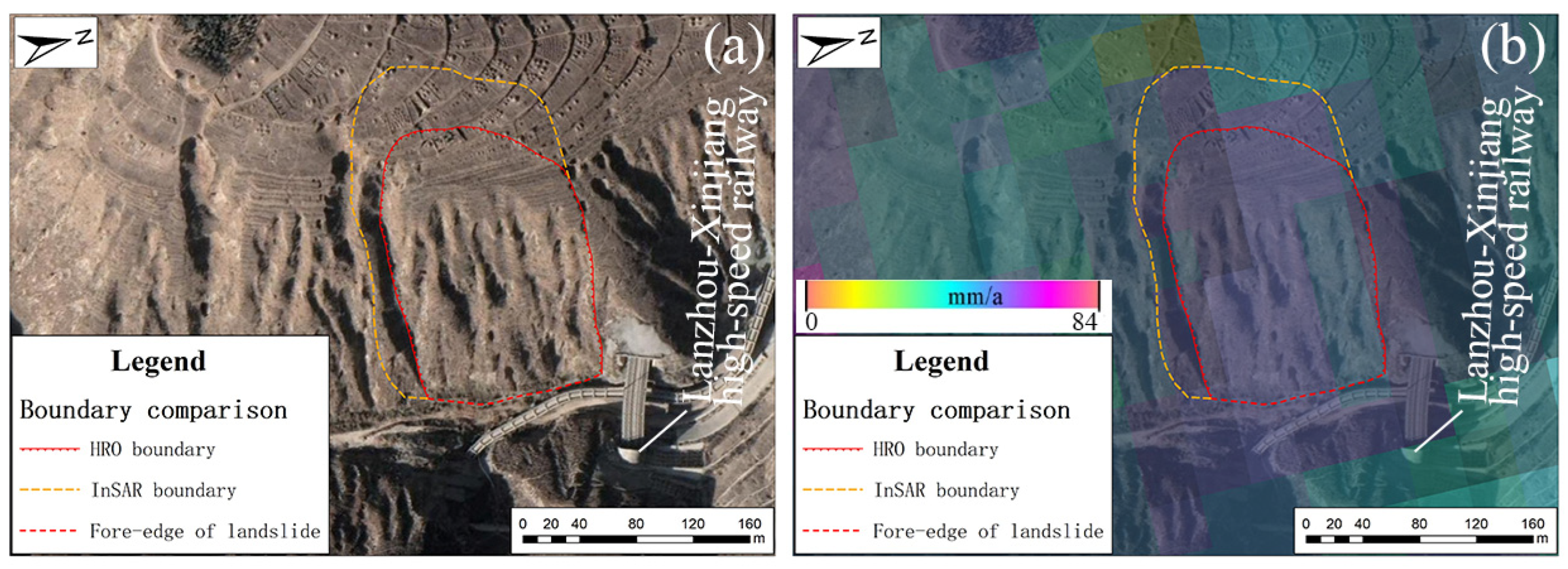
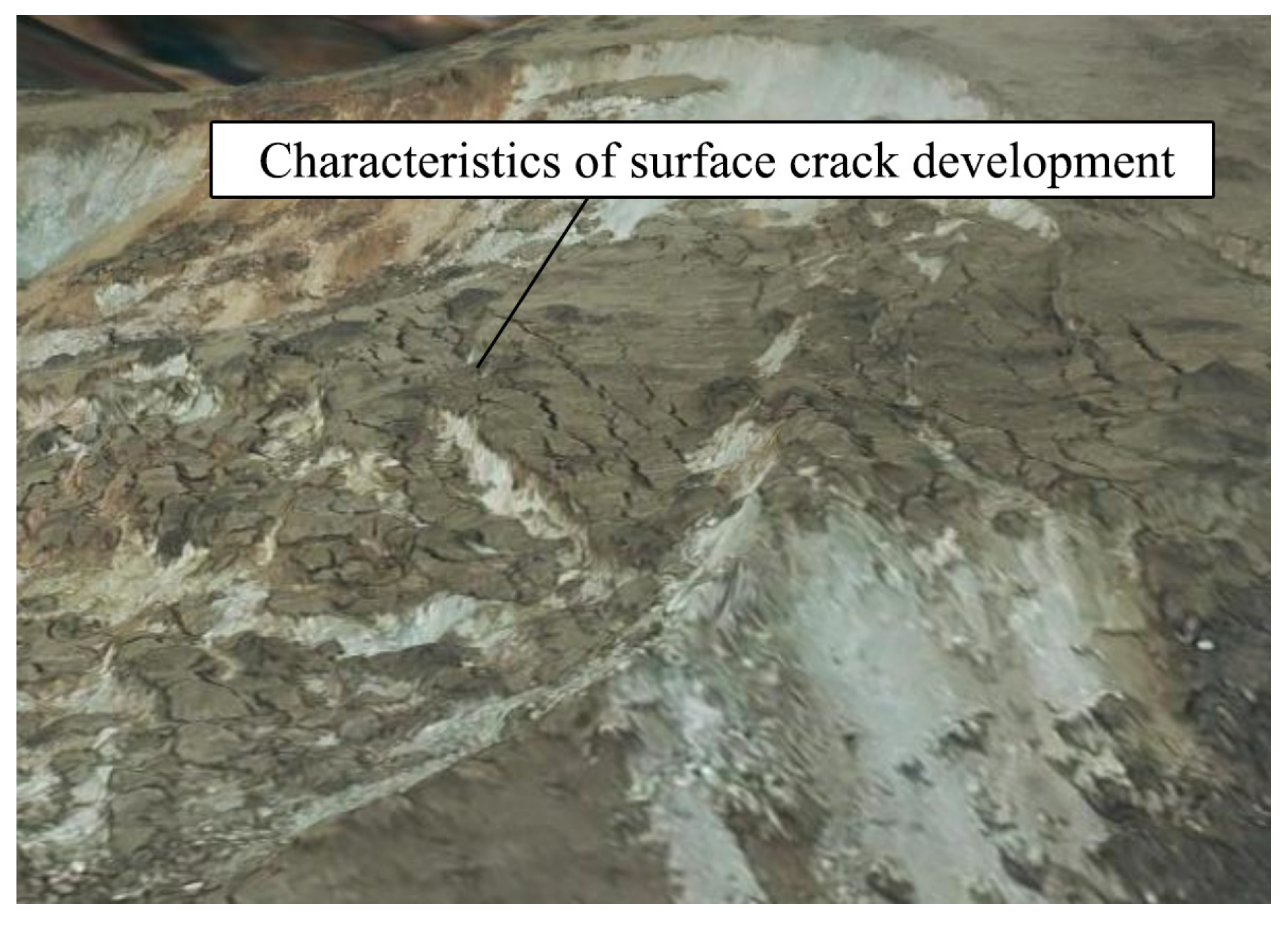
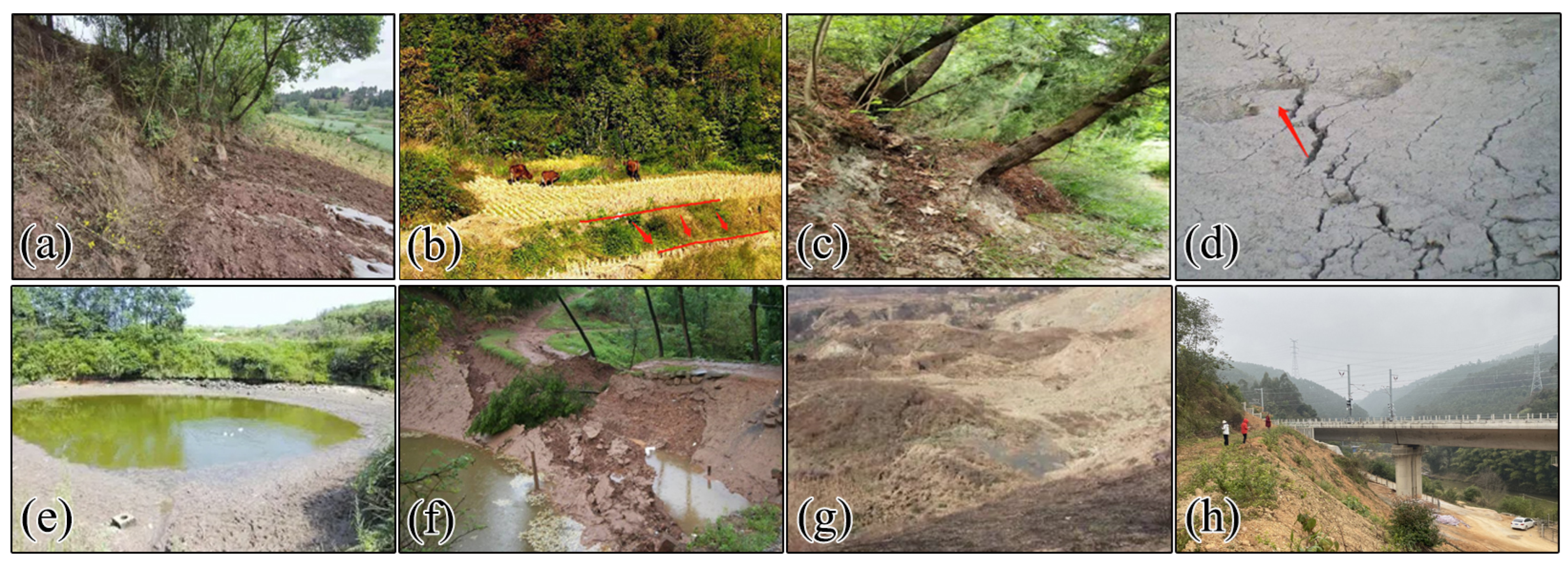
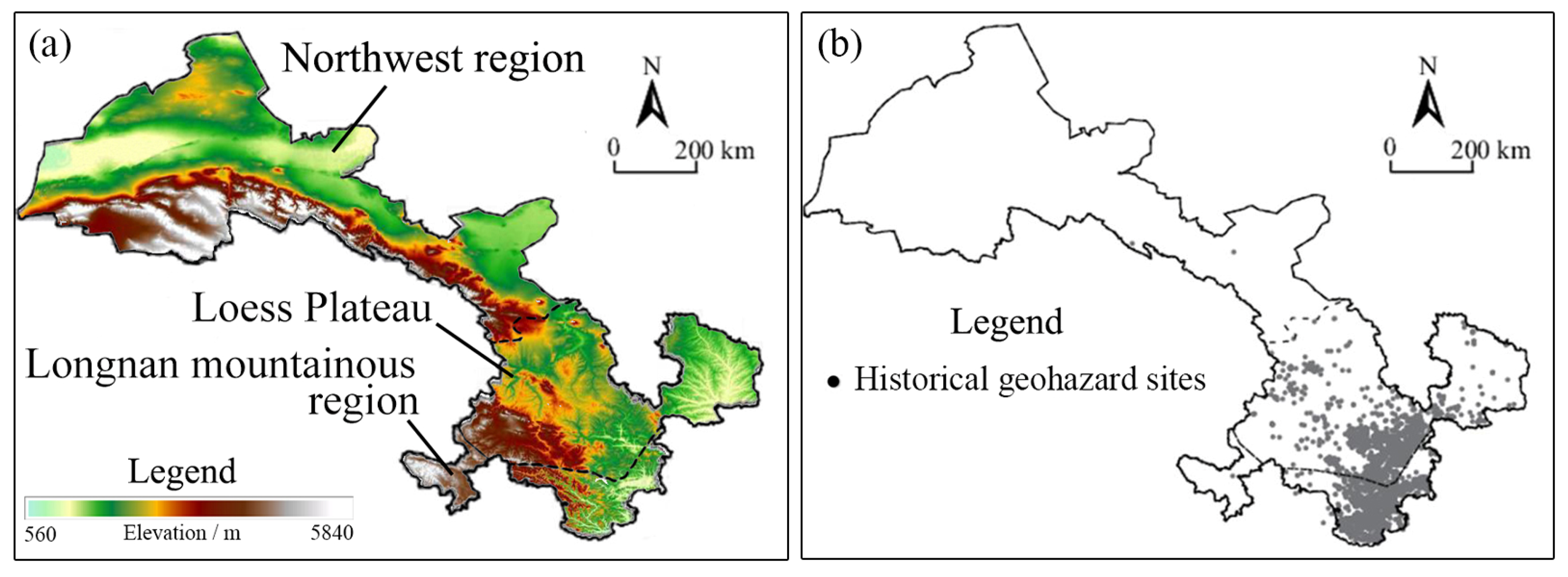
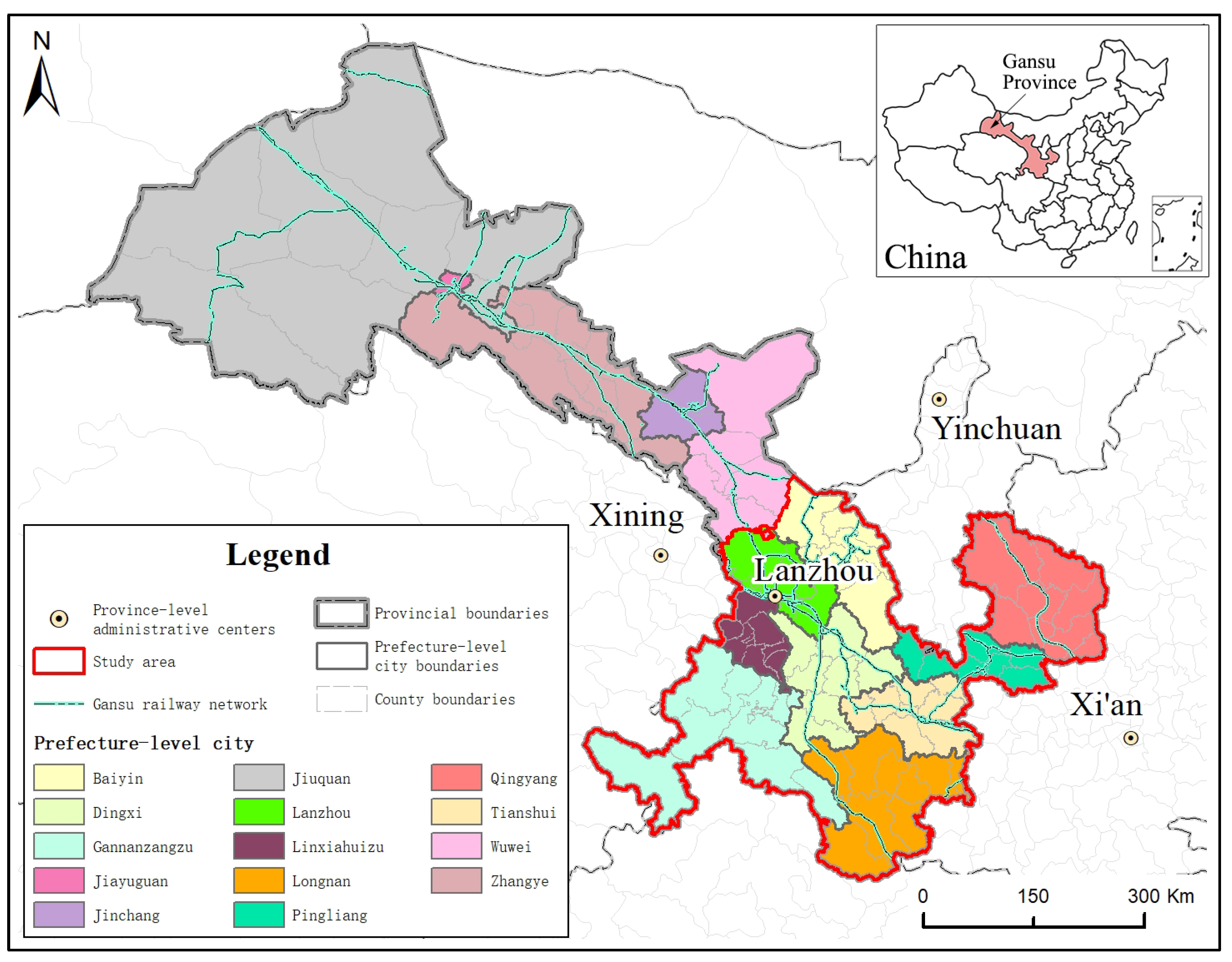
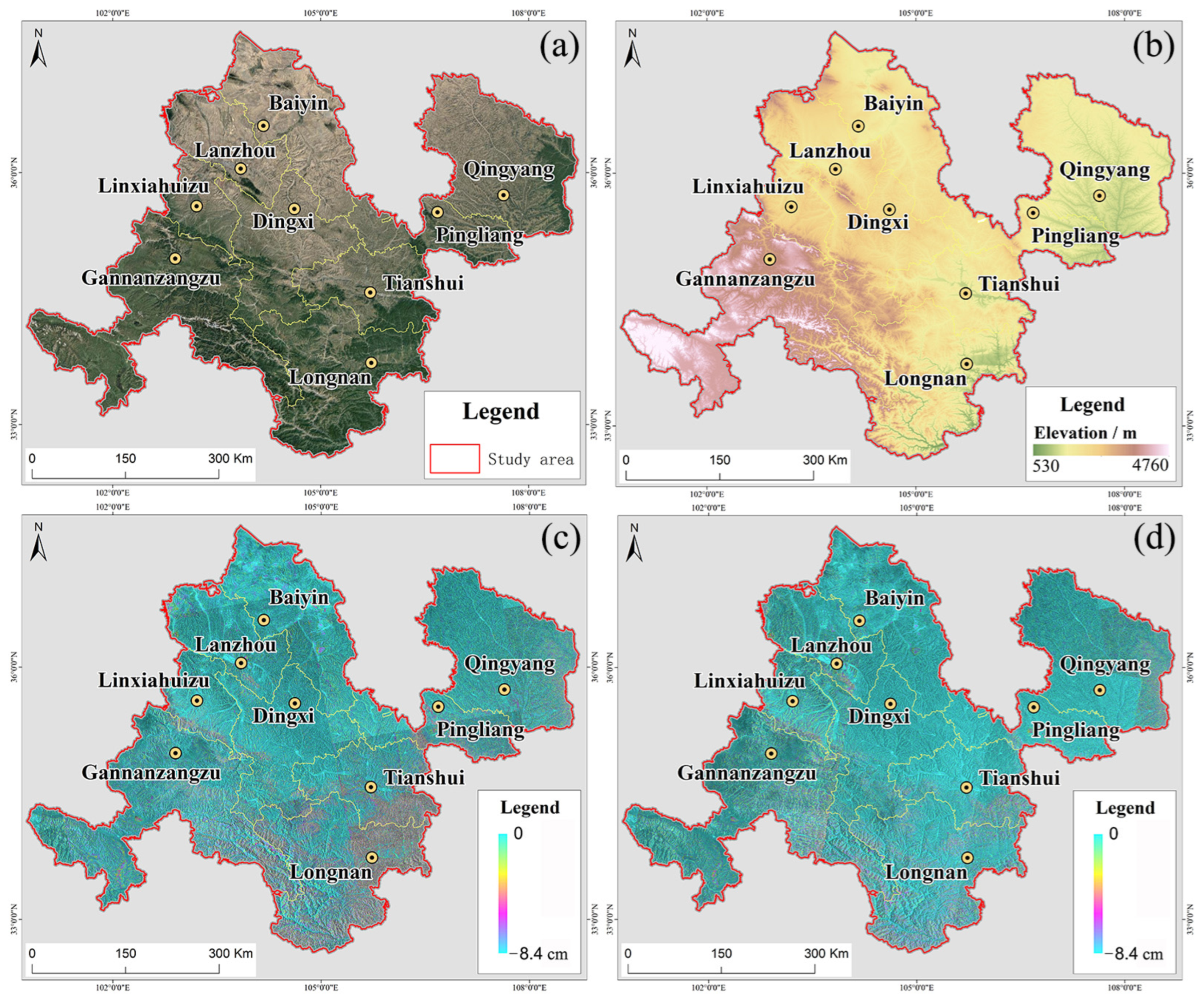
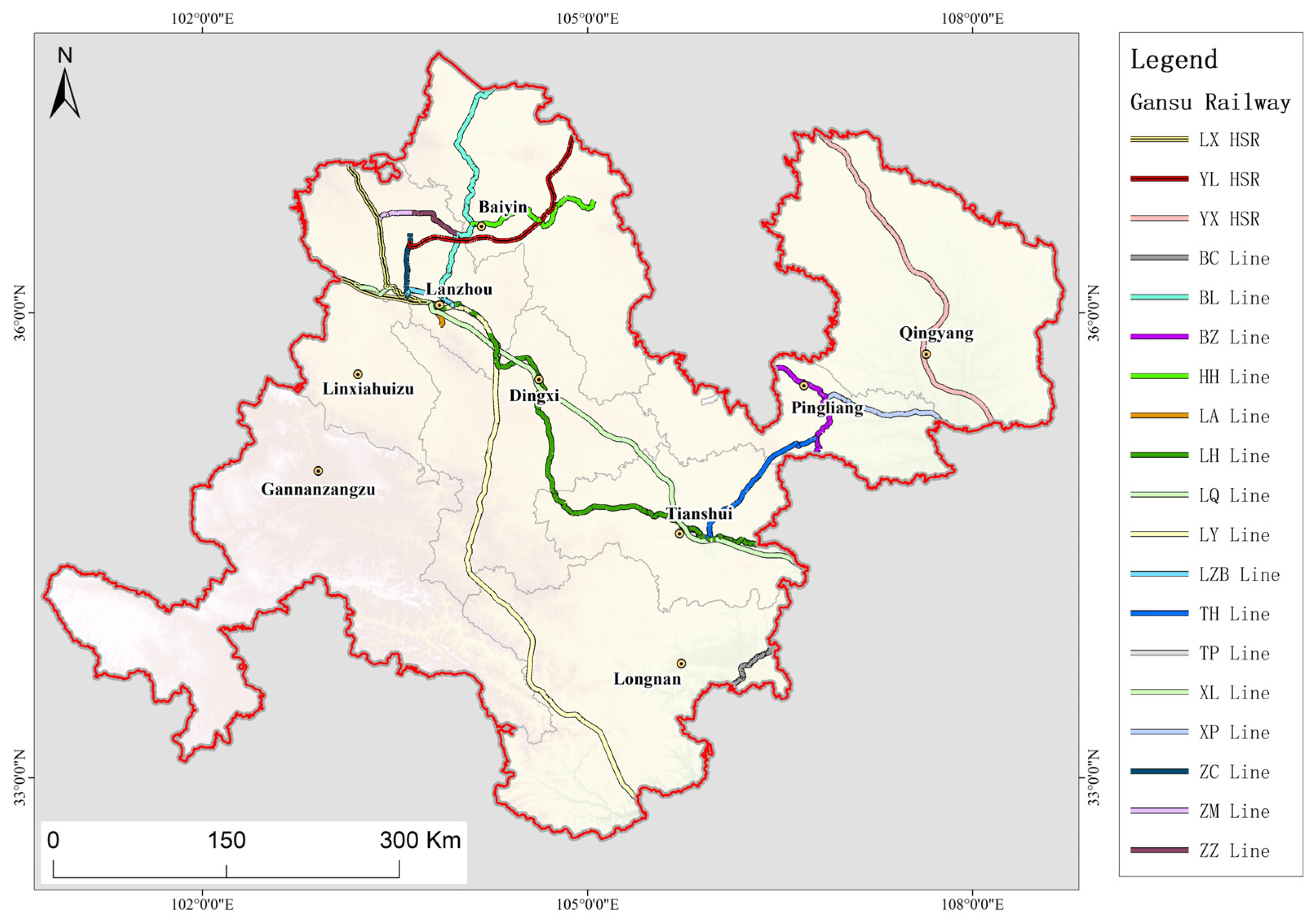
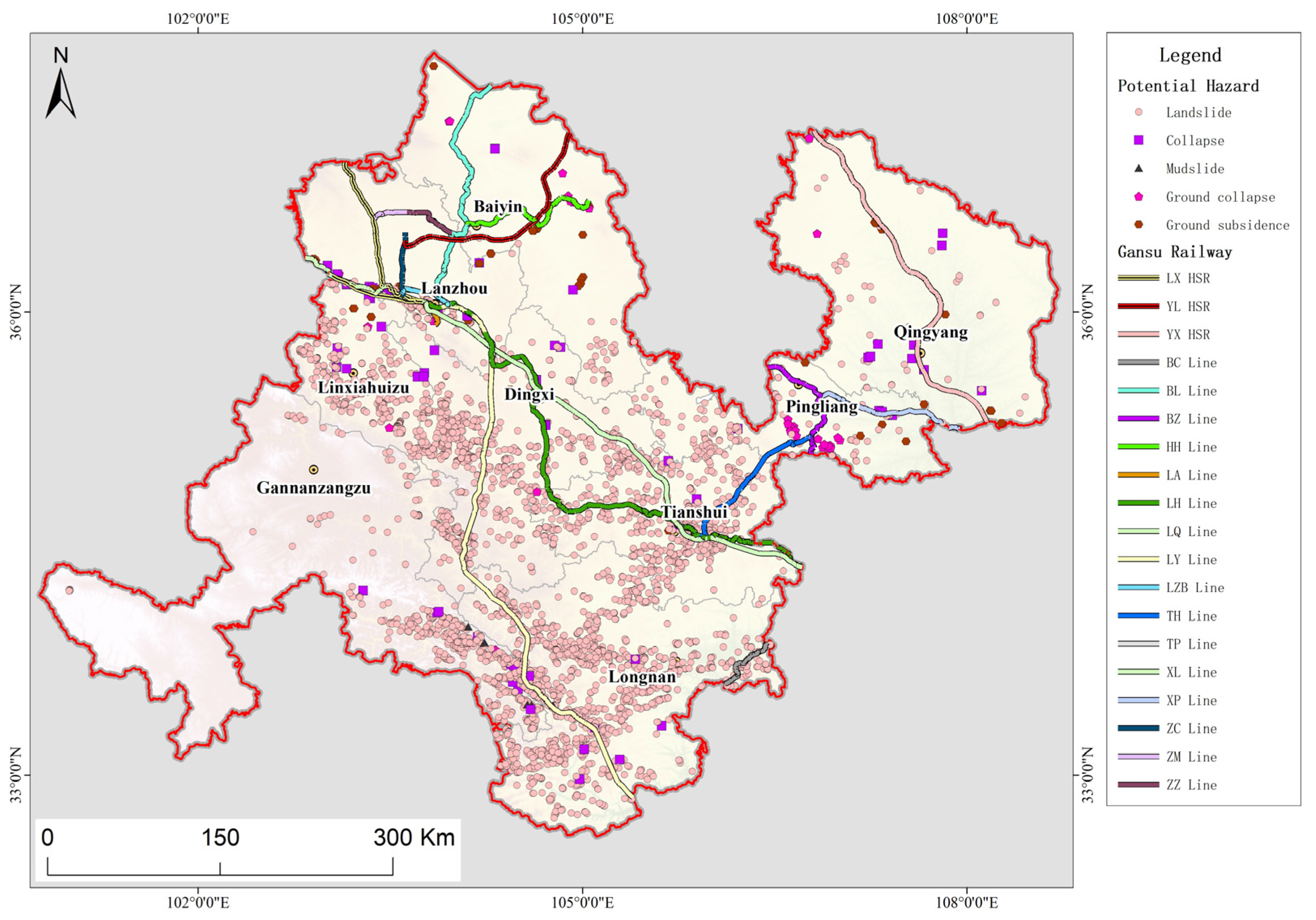
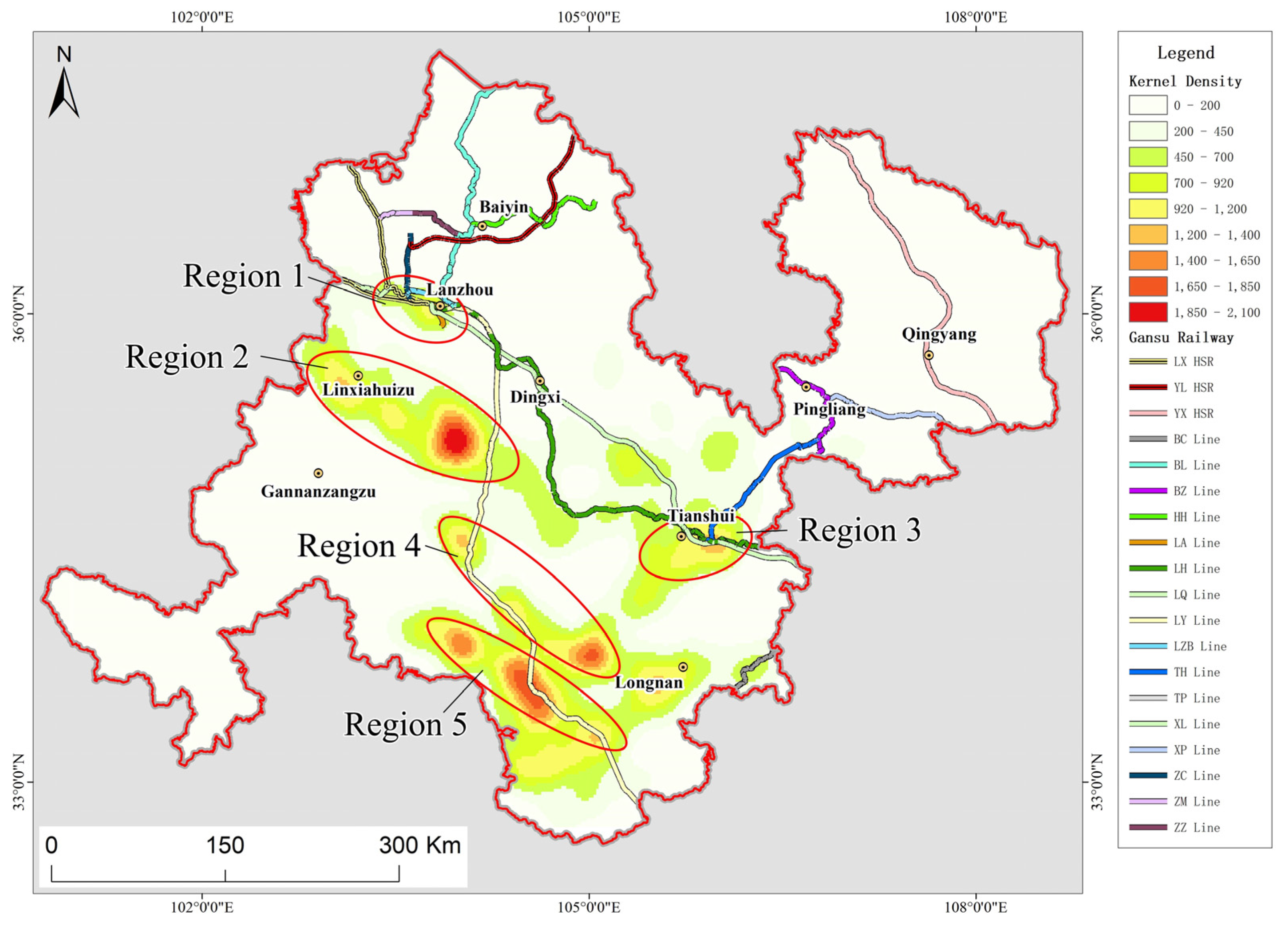
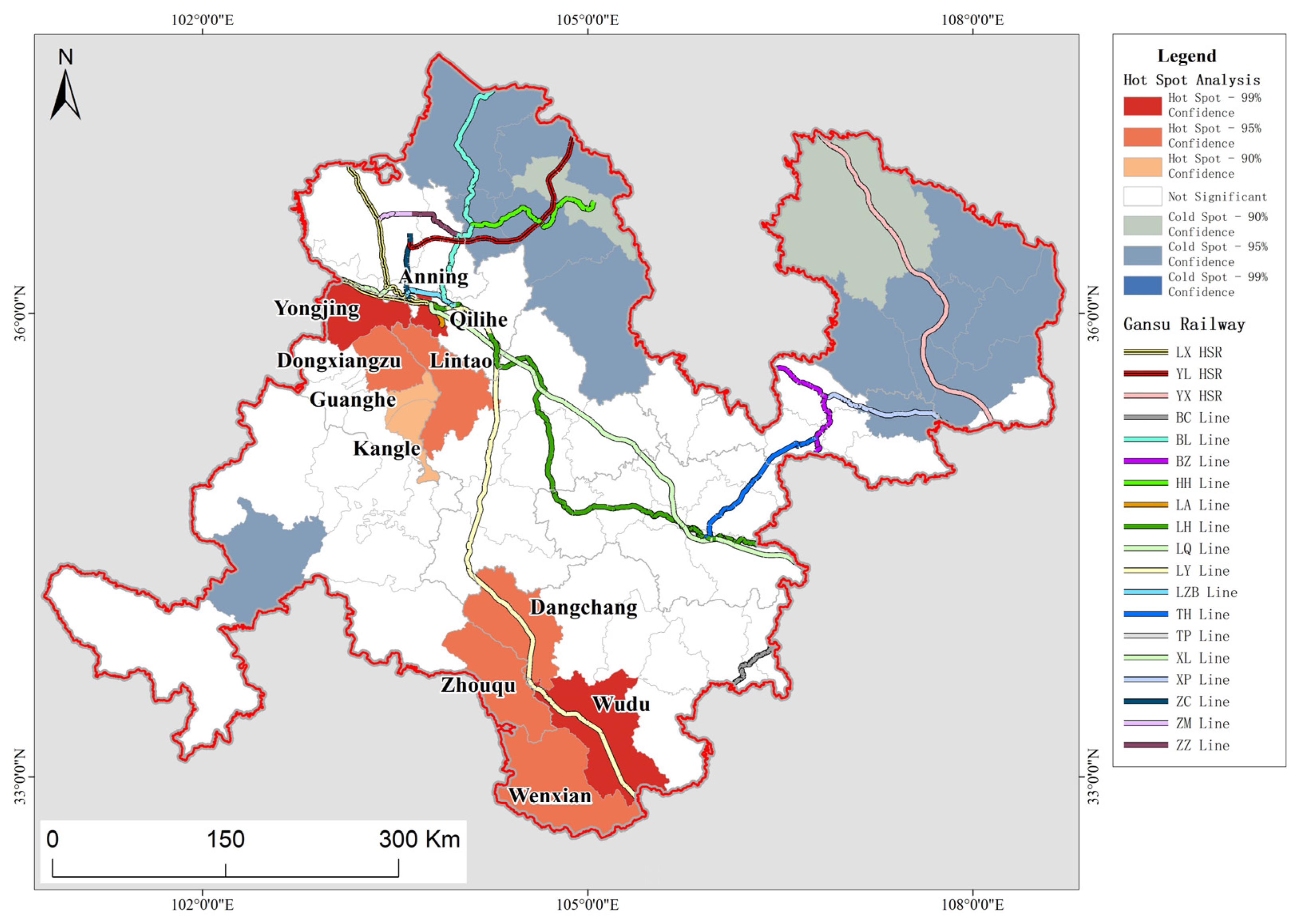


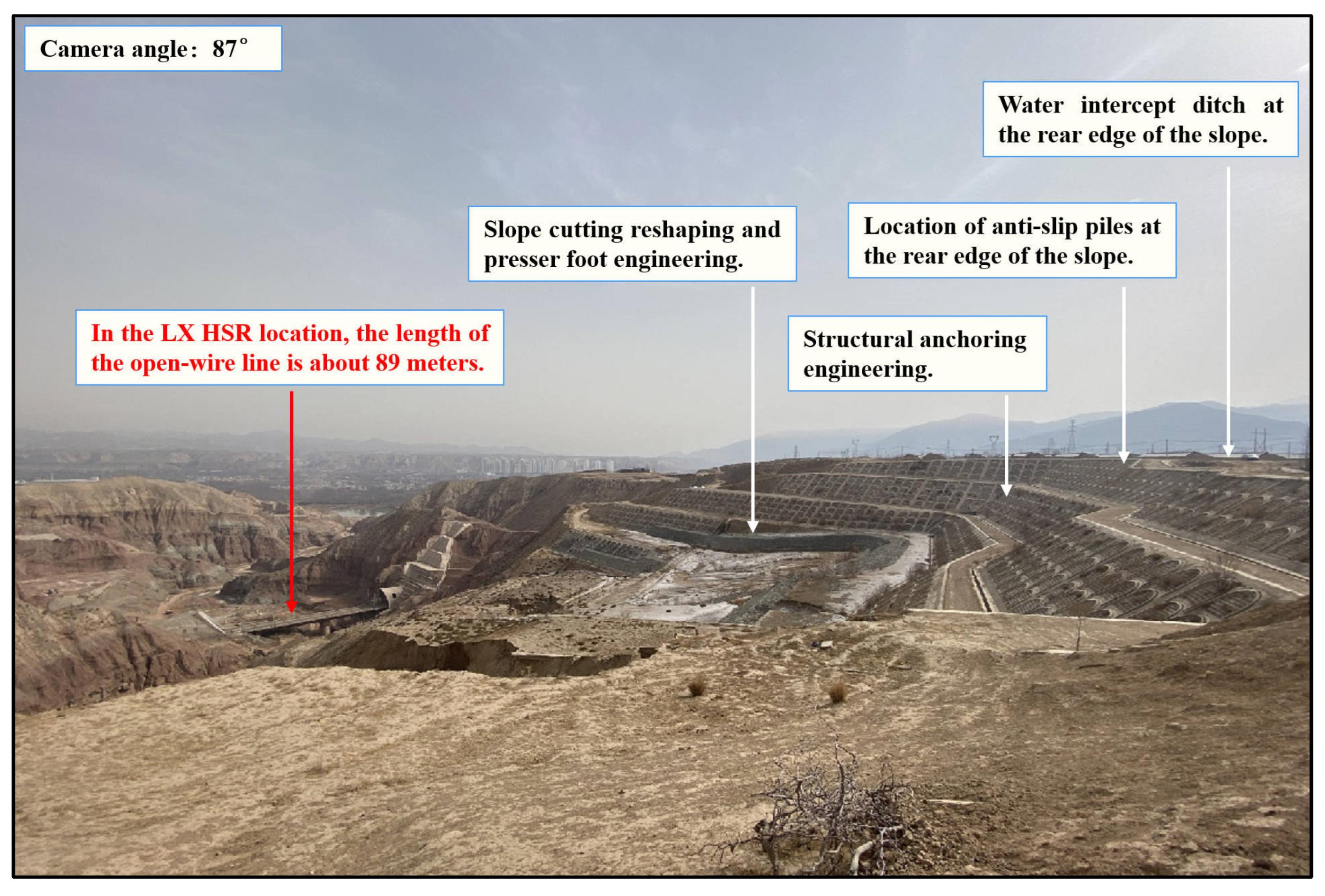

| Technical Approach | Advantages | Disadvantages | Applicable Scenarios |
|---|---|---|---|
| D-InSAR | Wide coverage, low data volume, low cost | Not suitable for slow deformation | Large-scale, general slow-change railway hazard monitoring |
| Stacking-InSAR | Wide coverage, low cost, high computational efficiency | Slightly less accurate than PS-InSAR and SBAS-InSAR | Large-scale, long-term slow-change railway hazard monitoring |
| PS-InSAR | Highly accurate and effective in urban areas | More data, low computational efficiency | Long-term slow-change railway hazard monitoring in urban areas |
| SBAS-InSAR | Less data, higher accuracy, extraction of non-linear deformation | Data processing is difficult and costly | Long-term slow-change railway hazard monitoring in critical areas |
| Risk Level | EHR | HR | MR | LR | |
|---|---|---|---|---|---|
| Threat Objects * | Railway Classification | Class 1 | Class 2 | Class 3 | Class 4 |
| Number of People | >100 | 50–100 | 10–50 | <10 | |
| Economic Loss | >50 million | 10–50 million | 5–10 million | <5 million | |
| Dataset | Dates | Application | Source | Website |
|---|---|---|---|---|
| GF-2 satellite images | January 2022 to June 2023 | Disaster identification | CRSA | https://data.cresda.cn/ (accessed on 3 July 2023) |
| ASTER GDEM V3 | February 2000 | SAR topographic correction | NASA | https://urs.earthdata.nasa.gov/ (accessed on 21 July 2023) |
| Sentinel-1 ascending images | January 2017 to December 2022 | Coherence measurements | ESA | https://scihub.copernicus.eu/ (accessed on 4 April 2023) |
| Sentinel-1 descending images | January 2017 to December 2022 | Coherence measurements | ESA | https://scihub.copernicus.eu/ (accessed on 4 April 2023) |
| Railway network data | May 2023 | Risk analysis | OSM | https://www.openstreetmap.org/ (accessed on 11 June 2023) |
| Geo-environmental data | August 2022 | Risk analysis | GGEM | -- |
| Historical geohazard data | April 2013 to October 2020 | Risk analysis | GGEM | -- |
| District and County | Number of Hidden Hazards | Area of Administrative Unit (km²) | Hazard Density (/km²) | Gi* Z-score | Gi* p-Value | Gi* Bin |
|---|---|---|---|---|---|---|
| Anning | 8 | 82.33 | 0.10 | 2.94 | 0.0033 | 3 |
| Qilihe | 39 | 397.25 | 0.10 | 2.89 | 0.0038 | 3 |
| Wudu | 271 | 4683.12 | 0.06 | 2.85 | 0.0043 | 3 |
| Yongjing | 62 | 1864.23 | 0.03 | 2.69 | 0.0070 | 3 |
| Dangchang | 207 | 3331.45 | 0.06 | 2.32 | 0.0205 | 2 |
| Dongxiangzu | 47 | 1510.12 | 0.03 | 2.01 | 0.0444 | 2 |
| Lintao | 148 | 2851.76 | 0.05 | 2.29 | 0.0221 | 2 |
| Wenxian | 239 | 4994.44 | 0.05 | 2.49 | 0.0128 | 2 |
| Zhouqu | 344 | 3010.29 | 0.11 | 2.40 | 0.0166 | 2 |
| Guanghe | 54 | 538.78 | 0.10 | 1.89 | 0.0582 | 1 |
| Kangle | 63 | 1083.12 | 0.06 | 1.74 | 0.0823 | 1 |
| Code | Type | Longitude | Latitude | Area (km²) | Threat Line | Risk Level |
|---|---|---|---|---|---|---|
| GS_0017 | Landslide | 103°20′01.11″ | 36°06′58.89″ | 0.06 | LX HSR | HR |
| GS_2566 | Landslide | 104°43′52.90″ | 33°27′56.50″ | 0.66 | LY Line | HR |
| GS_0504 | Landslide | 103°25′26.72″ | 36°08′30.18″ | 0.11 | LQ Line | MR |
| GS_1459 | Landslide | 104°45′07.21″ | 33°27′01.84″ | 0.23 | LY Line | MR |
| GS_2992 | Landslide | 104°58′41.00″ | 33°22′13.03″ | 0.25 | LY Line | MR |
| GS_3152 | Landslide | 104°32′36.22″ | 33°39′24.78″ | 0.37 | LY Line | MR |
| GS_3345 | Landslide | 103°34′24.73″ | 36°05′11.78″ | 0.16 | LX HSR | MR |
| GS_3379 | Landslide | 103°32′46.51″ | 36°06′24.80″ | 0.18 | LX HSR | MR |
| GS_3384 | Landslide | 103°37′27.85″ | 36°04′15.04″ | 0.02 | LX HSR | MR |
| GS_3686 | Landslide | 106°18′19.38″ | 34°31′21.89″ | 0.07 | LH Line | MR |
| GS_3688 | Landslide | 106°02′59.34″ | 34°33′44.95″ | 0.26 | TH Line | MR |
| GS_3689 | Landslide | 106°02′13.88″ | 34°34′17.82″ | 0.12 | LH Line | MR |
| GS_3692 | Landslide | 105°57′25.52″ | 34°35′20.38″ | 0.38 | TH Line | MR |
| GS_3693 | Landslide | 105°57′32.51″ | 34°35′35.89″ | 0.46 | TH Line | MR |
| GS_3799 | Landslide | 103°50′37.98″ | 35°59′25.71″ | 0.22 | AL Line | MR |
| GS_0350 | Landslide | 104°32′59.04″ | 33°36′38.93″ | 0.30 | LY Line | LR |
| GS_0940 | Landslide | 104°45′50.73″ | 33°26′26.01″ | 0.63 | LY Line | LR |
| GS_0941 | Landslide | 104°44′13.93″ | 33°27′47.19″ | 0.18 | LY Line | LR |
| GS_1458 | Landslide | 104°44′46.07″ | 33°27′19.13″ | 0.23 | LY Line | LR |
| GS_3800 | Landslide | 103°50′23.25″ | 35°59′48.65″ | 0.17 | AL Line | LR |
Disclaimer/Publisher’s Note: The statements, opinions and data contained in all publications are solely those of the individual author(s) and contributor(s) and not of MDPI and/or the editor(s). MDPI and/or the editor(s) disclaim responsibility for any injury to people or property resulting from any ideas, methods, instructions or products referred to in the content. |
© 2023 by the authors. Licensee MDPI, Basel, Switzerland. This article is an open access article distributed under the terms and conditions of the Creative Commons Attribution (CC BY) license (https://creativecommons.org/licenses/by/4.0/).
Share and Cite
He, P.; Guo, Z.; Chen, H.; Shi, P.; Zhou, X.; Wang, G. Research and Application of Early Identification of Geological Hazards Technology in Railway Disaster Prevention and Control: A Case Study of Southeastern Gansu, China. Sustainability 2023, 15, 16705. https://doi.org/10.3390/su152416705
He P, Guo Z, Chen H, Shi P, Zhou X, Wang G. Research and Application of Early Identification of Geological Hazards Technology in Railway Disaster Prevention and Control: A Case Study of Southeastern Gansu, China. Sustainability. 2023; 15(24):16705. https://doi.org/10.3390/su152416705
Chicago/Turabian StyleHe, Peng, Zhaocheng Guo, Hong Chen, Pengqing Shi, Xiaolong Zhou, and Genhou Wang. 2023. "Research and Application of Early Identification of Geological Hazards Technology in Railway Disaster Prevention and Control: A Case Study of Southeastern Gansu, China" Sustainability 15, no. 24: 16705. https://doi.org/10.3390/su152416705
APA StyleHe, P., Guo, Z., Chen, H., Shi, P., Zhou, X., & Wang, G. (2023). Research and Application of Early Identification of Geological Hazards Technology in Railway Disaster Prevention and Control: A Case Study of Southeastern Gansu, China. Sustainability, 15(24), 16705. https://doi.org/10.3390/su152416705







